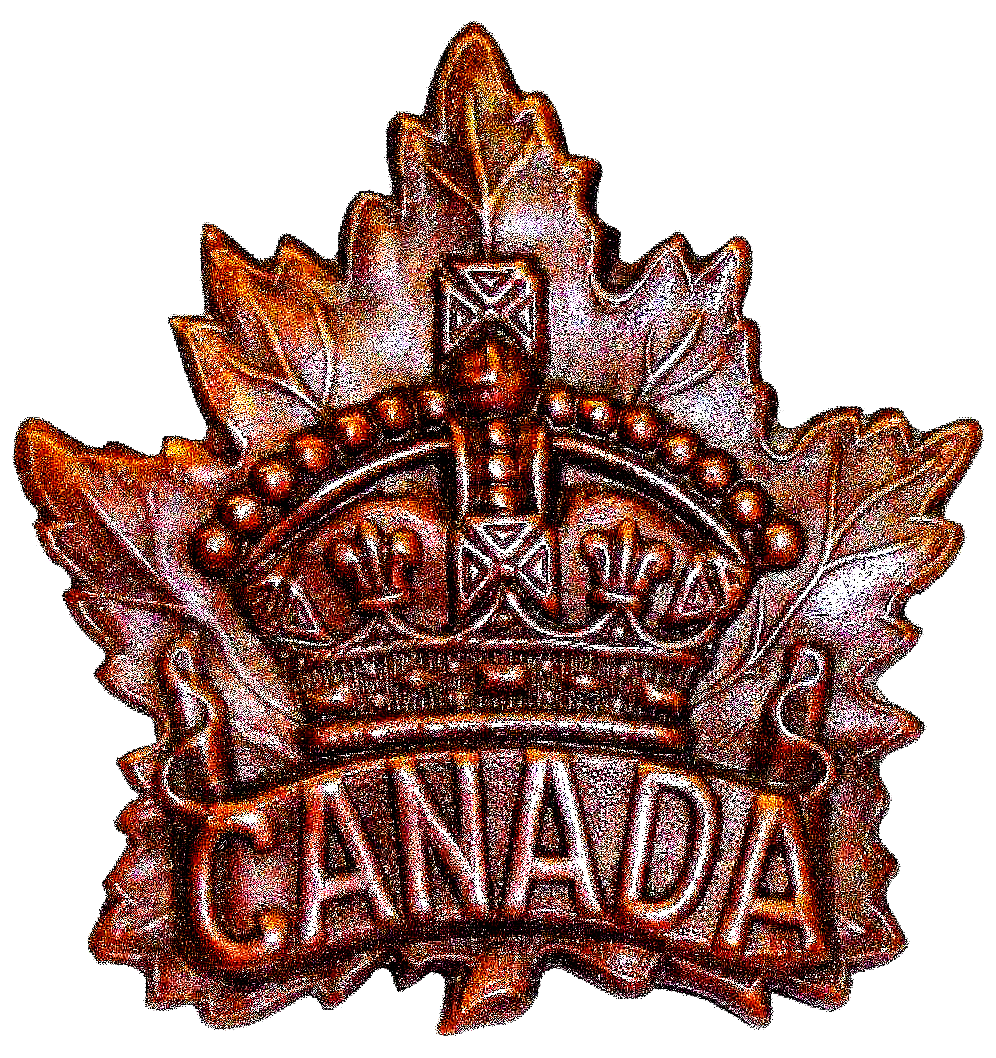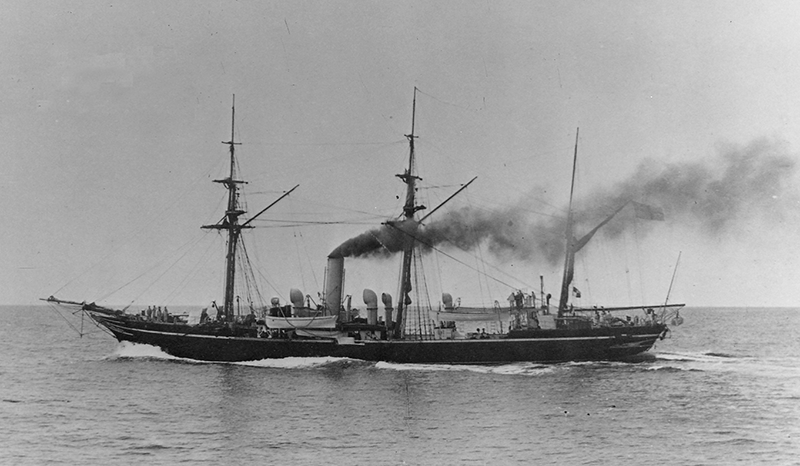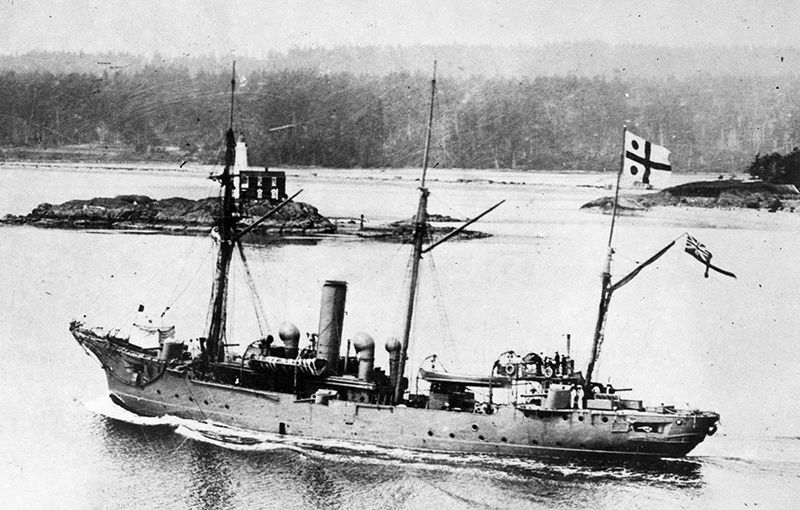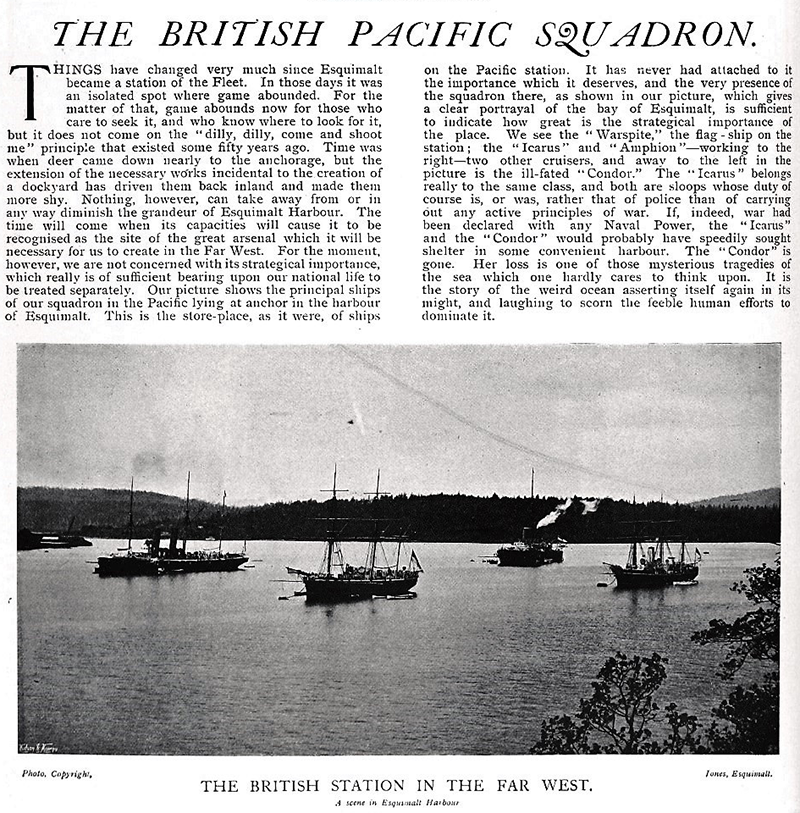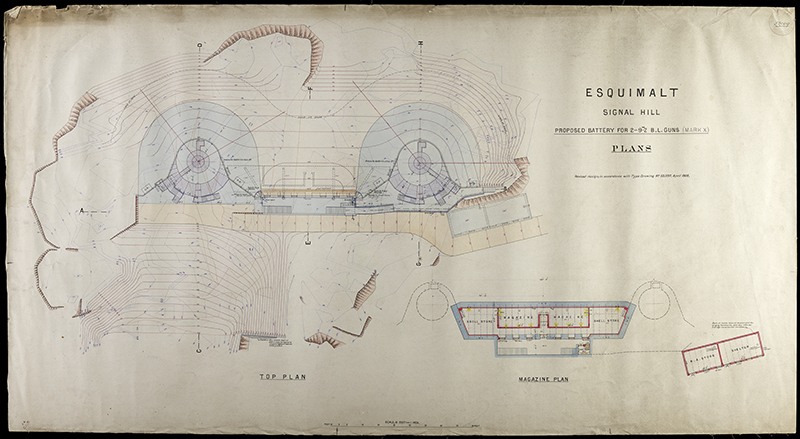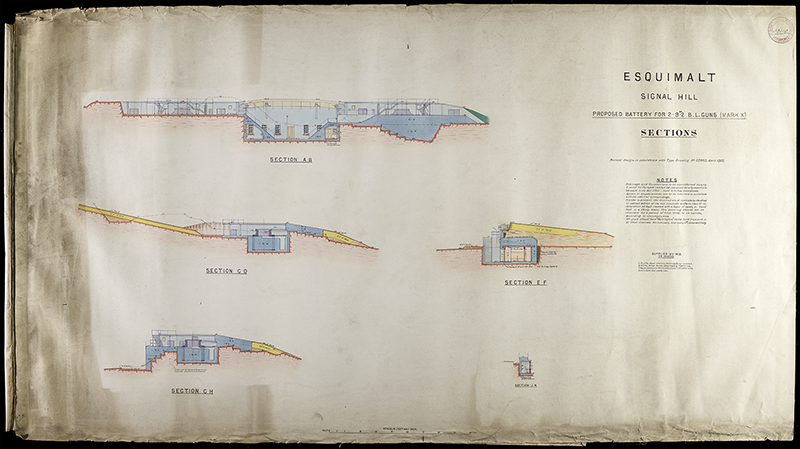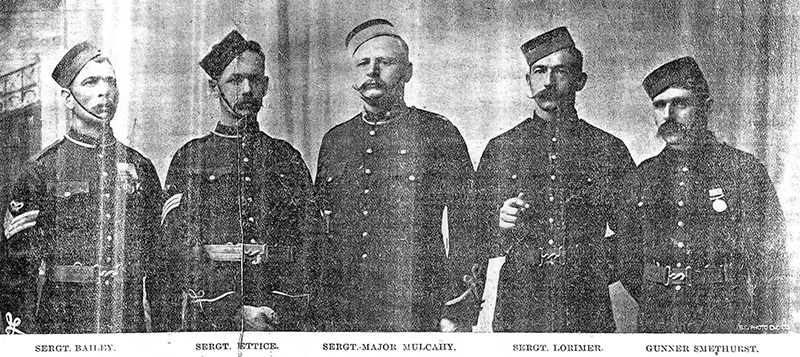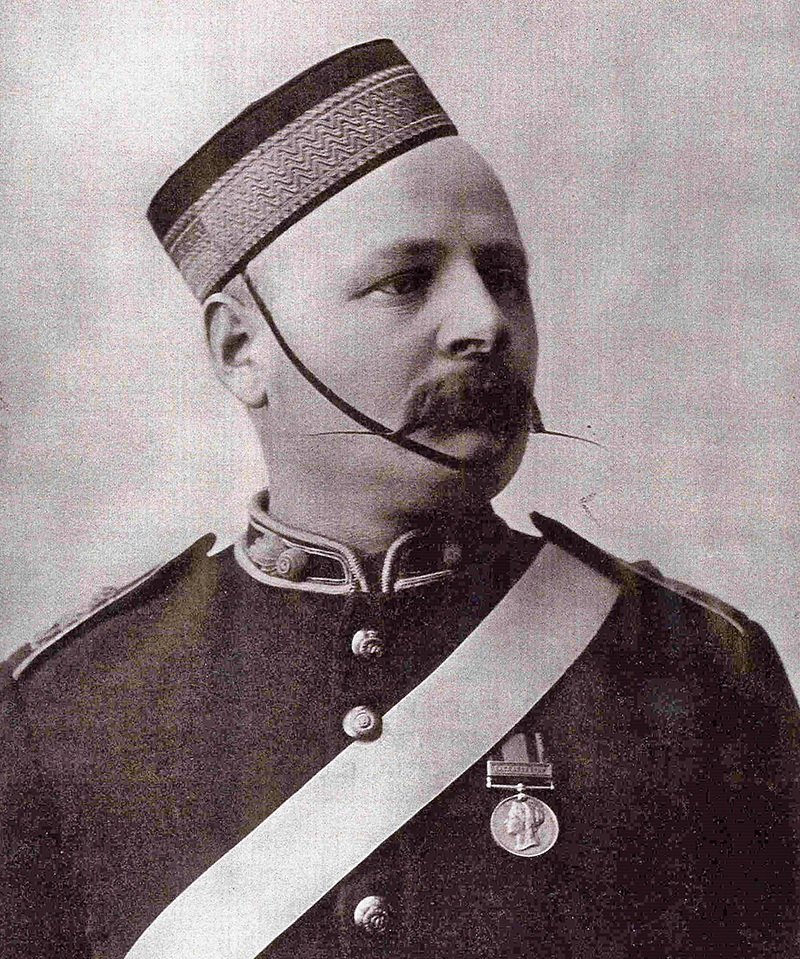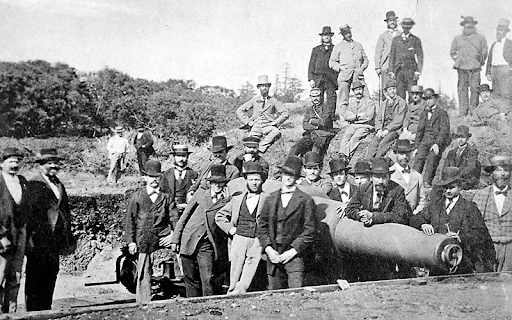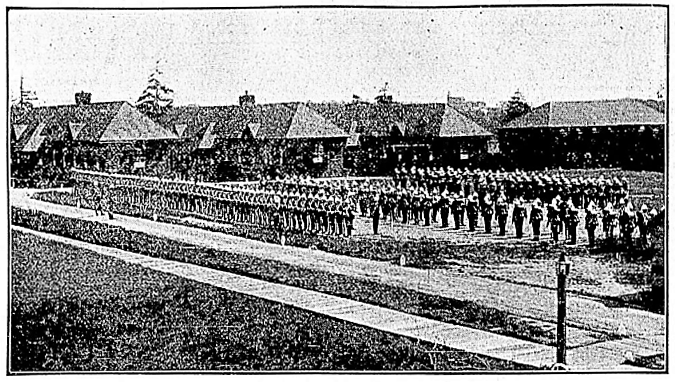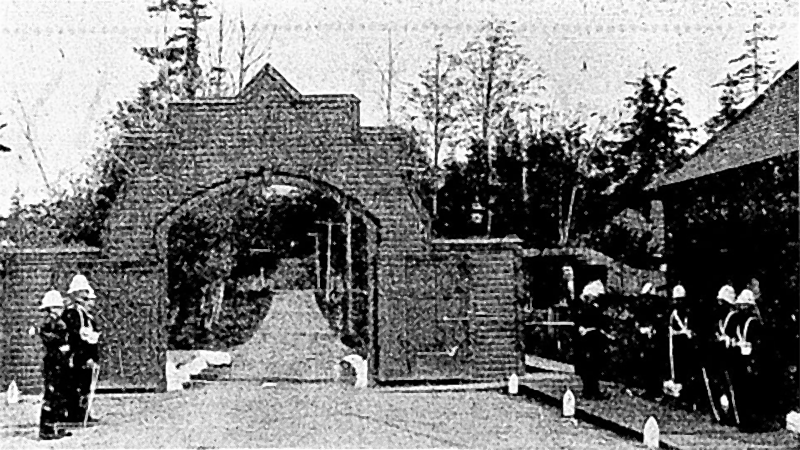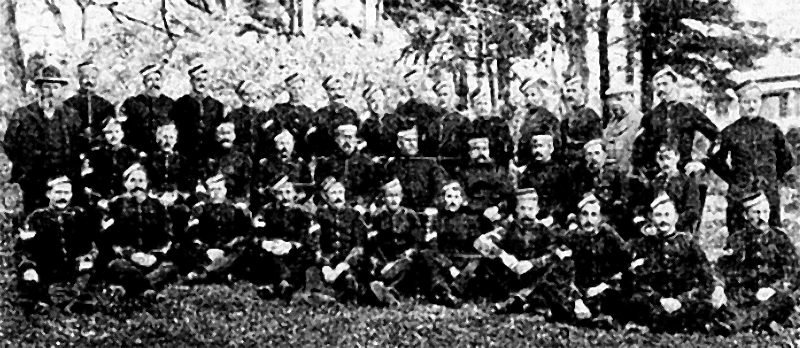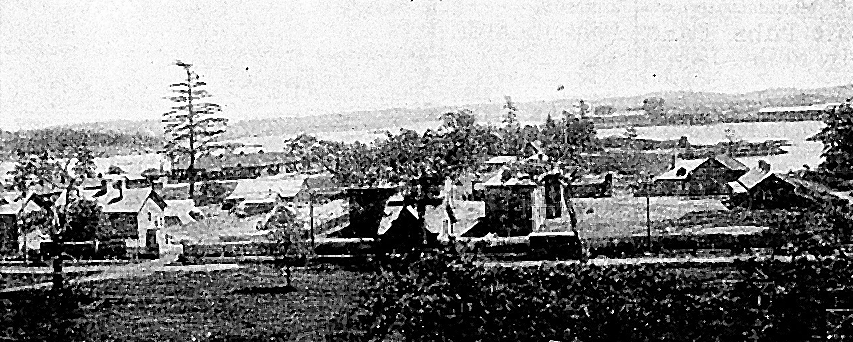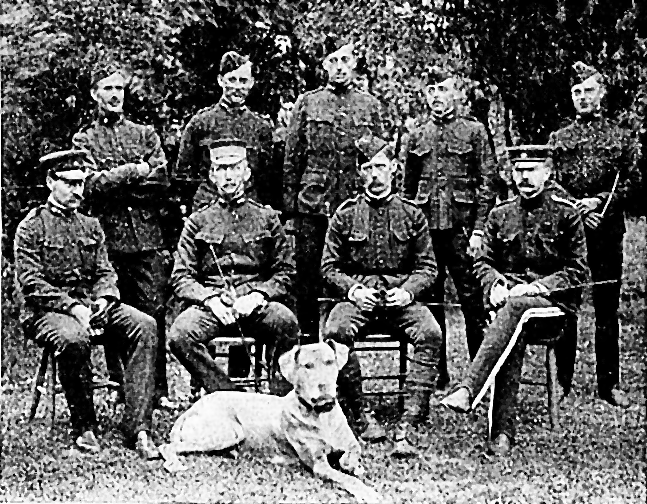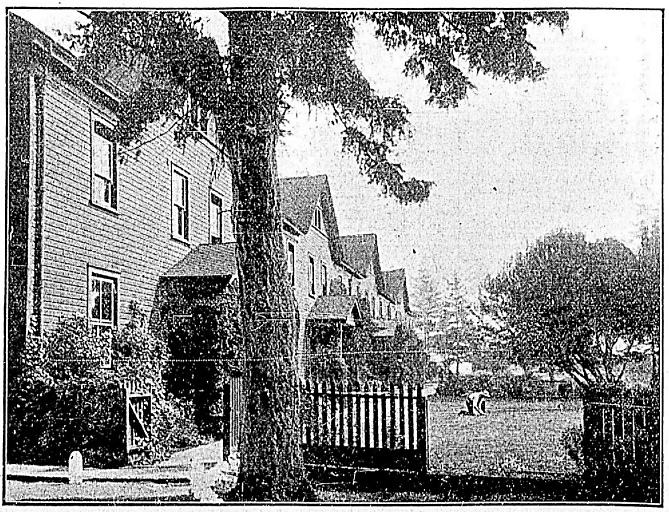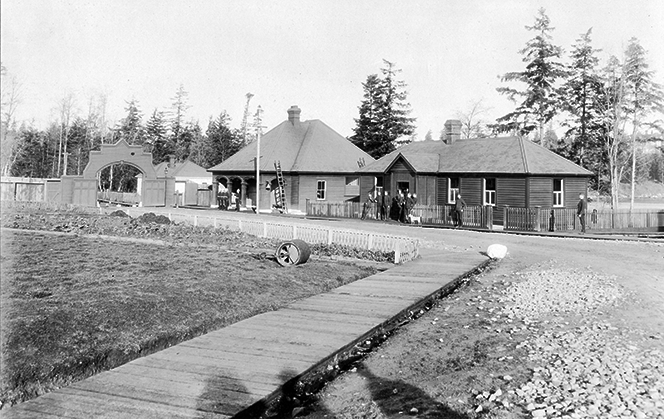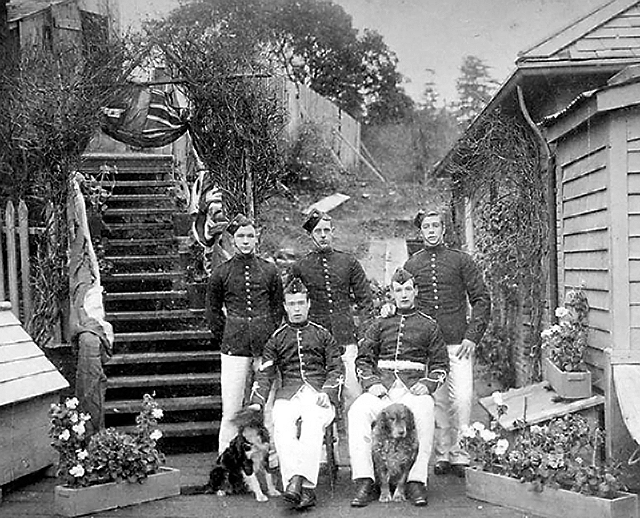 |
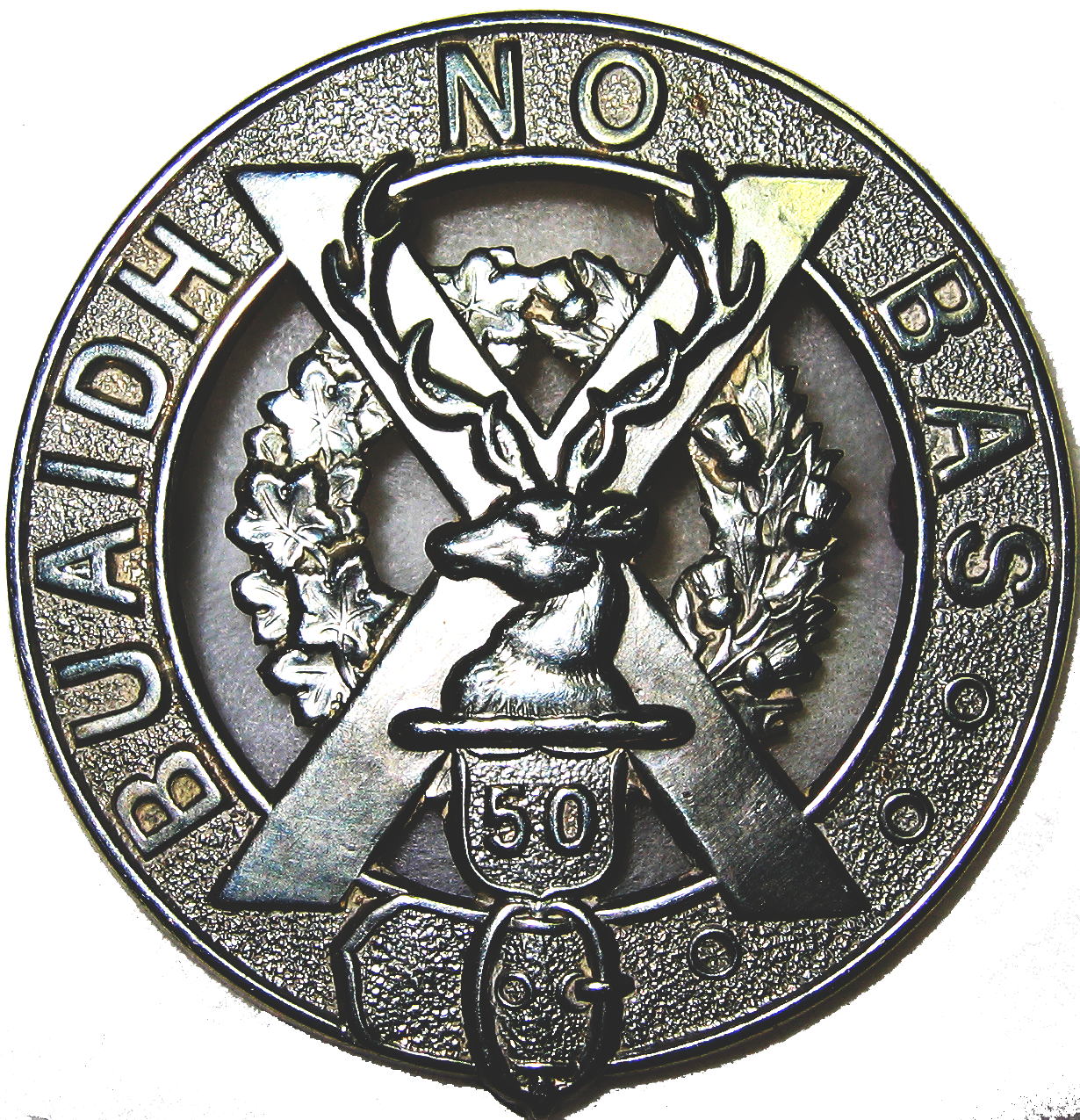 OPCMHVisitor No.: |
HISTORY OF WORK POINT BARRACKSby Jack BatesPART 3 — 1894 to 19061902R. Clapp — 21 Company was renumbered as 83 Company and "Western Division" was dropped from the title when the Royal Garrison Artillery was reorganized. COLONIST SEARCH FOR H.M.S. CONDOR H.M.S. Egeria (surveying vessel of 900 tons), which has been searching for the missing gunboat H.M.S. Condor, is overdue. Anxiety is felt in regard to her in consequence of some wreckage being found at Vancouver which is believed to be the Egeria’s. Later….. The surveying vessel Egeria, which was searching for the missing sloop Condor, and which was some time overdue, has arrived safe at Vancouver. The Egeria has brought to Vancouver some wreckage of the Condor, including a deck grating, some deck sheathing, and the signal box.
Photos Courtesy CFB Esquimalt Base Museum. Daily Colonist VICTORIA HUNT CLUB Enjoyable Run, But Several Accidents, Happily Not Serious The Victoria Hunt Club met yesterday at the Work Point barracks, and it is a pity that the place is so difficult to find, for a keen sportsman and bold rider who left his happy home to brave the perils of the chase, never arrived there, and will, doubtless, be grievously disappointed at having missed the excellent run which others, better acquainted with the locality, enjoyed. The hares had the usual five minutes law, and crossing the golf links in a direction more or less parallel with the coast, they followed a trail through the timber and crossed the Esquimalt road a little beyond where the Admirals road branches off it. They traversed some rough ground and jumped an old log fence and followed the Admiral's road nearly as far as the Transfer company's fields, and jumping some slip bars of a goodly height into the wood, went by way of certain trails to Lampson street, near the junction with Head street. They then turned down Head street and worked across the country to Craigflower and by highways, byways, and fields to Mr. Barker's farm at Strawberry Vale, where, their paper being exhausted, they pulled up to wait for their pursuers. Not all of those who started arrived at the finish — some fell by the wayside, and some coming upon a broad highway, found it good to follow towards home; but a lady, a few men and two boys struggled gamely to the end where they arrived not without misadventure. The lady had a fall and the rider of a crazy hot-tempered horse had a couple; but another sportsman, who seldom performs such antics, turned several sumersaults over a fence, his horse following after in one revolution, which led to an entanglement hard to unravel. Fortunately no serious injury resulted from any of these little mishaps; but such incidents, and repeated refusals, mean delay; consequently the hares gained at least 15 minutes, although they had not ridden fast and had also done a little refusing. They did their part of the business in an hour and five minutes. It is generally acknowledged that unless in a steeplechase, where risks are taken, it is bad policy to ride fast at high timber. It is also a good plan to let the man in front get over a fence before jumping the same panel, because two bodies cannot occupy the same space. Of course the rider of a charger of great size and weight may be able to clear the way if he has a thirst for the blood of his pilot; but riding members being, at the present time, scarce in the Hunt Club, it is, on the whole, fortunate that serious collisions have so far been (almost miraculously at times) averted. February 28, 1902 SPORTING INTELLIGENCE Opening Run of the Work Point Harriers Held Yesterday Afternoon The Work Point Harriers held their first opening run yesterday afternoon. They were favored with splendid weather, but the roads were very heavy. The hares, Bombr. Wills and Gr. Campion, were given seven minutes start, and leaving the barracks at 2:35, laid a good trail through the bush just outside the barracks, and coming out on the Esquimalt road near the St. George's Inn. Crossing the road, they made their way through the woods and fields to Pine street, and thence to Craigflower road and the Gorge bridge. Leaving the Gorge, they proceeded to Craigflower bridge and returned via the Admirals and Esquimalt roads, Kanaka ranch and Macaulay Point to the barracks. They were away just 10 minutes short of an hour, and gained eight minutes on the hounds, of whom there were 20. The prize offered by the commanding officer for the first man home after the hares was won by Gr. Sheedy. There will be another run on Thursday next. The NAVY AND ARMY ILLUSTRATED ESQUIMALT – 1902
SIGNAL HILL The two plans following were the designs (Plan and Sections) for the proposed 2 - 9.2 inch BL Gun Battery on the top of Signal Hill in Esquimalt.
Click here for above image as a PDF file
Click here for above image as a PDF file COLONIST CORONATION CONTINGENT Five Soldiers Selected to Represent Victoria Regiment at the Ceremony Selection Made Yesterday at the Drill hall by Col. Holmes “Soon we’ll be in London town; See the King with a golden crown.” Five members of the Fifth Regiment, Canadian Artillery, were selected yesterday as the representatives of Victoria in the Canadian Contingent which is to march with the colonial troops in London when the King is crowned. After the Regiment’s inspection was completed, the candidates were paraded, 32 in all, and the D.O.C., Col. Holmes, commenced the selection of the local contingent. A number were disqualified by reason of the fact that they had not attended the drills for the past three years, and twelve were left. The veterans were given the first call, those who served in the North West Rebellion being first called. Sergt. - Major Mulcahy was the only veteran of the fights against Riel’s armies. Then came several South African veterans, and Sergt. Bailey, who served in the Sudan campaign. Ten were selected, the order in which they were chosen being as follows: Sgt.-Maj. Mulcahy – served with A Battery of the RCA in the North West Rebellion, fighting for 8 months with that corps. He was present at the battles of Fish Creek and Batoche. Company Sgt. W. Bailey, who served for 12 years in the Royal Marine Light Infantry, and wears the medal for the Egyptian War. He fought at several battles of that campaign in the Soudan, notably Abu Klea. Company Sgt.-Maj H Lettice, who is an expert rifle shot, and has been both to Bisley and Ottawa to represent B.C. He has won many honors with the rifle. Gr. H. Smethurst, who was a member of the 1st Canadian Contingent, and marched with the Canadians from Capetown to Pretoria and fought in that fame-making fight of Paardeburg. Gr. G Neil, who fought with the 1st Canadian Contingent at Paardeburg and other engagements of the march to Pretoria. Company Sgt. E. Viger, Sgt. R. Lorimer, Sgt. Rex Harris, Gr. T.N. Hibben, Gr. W.H. Spurrier, who, although not having been on active service has served with the Royal Marine Artillery for some time. He secured his discharge from that corps here. These 10 were then examined by Dr. Hart, the Regimental Surgeon–Major. Some were disqualified, some because they were not the required height and for other reasons, and finally 5 were selected.
For more on Major Andrew Mulcahy, see the TIMES - December 16, 1935 (1); COLONIST – December 17, 1935 (5) (7); PROVINCE – December 17 (8). Major Mulcahy (1935) and his wife Harriet (1950), who made their homes in Esquimalt, are both buried in the Veteran’s Cemetery. May 25, 1902 Local News Travelled in Pairs. — The police fore on the business portion of the city last night was doubled, the officers parading Government street in pairs. While there were no serious disturbances, the men were kept busy separating a few over enthusiastic celebrators, who got into "mix-ups". A patrol from Work Point barracks also was out, both at the Gorge during the afternoon and in the city at night, to look after the soldiers, but they had little or nothing to do. May 29, 1902 INSPECTION PROGRAMME General Parsons Spends the Next Few Days Over the Works Major General Sir Charles Parsons, K.C.M.G., commander in chief of the Imperial forces in Canada, begins his round of inspection of the establishments comprising this station this morning, and will be engaged in this work until Tuesday of next week. Yesterday was spent by General Parsons in conferring with the heads of the various departments of the station. A formal call was also made upon Admiral Bickford, who received the General's party on the flagship H.M.S. Grafton with the customary honors. This morning will be held the inspection of the batteries at Macaulay Point, from which gun practice with the 6 inch breech loaders will be held. This begins at 11 o'clock, and will be followed at noon with the inspection of the submarine mining and ordnance establishments at Signal Hill, while from Black Rock battery and Duntze Hill emplacements gun practice with the Q.F. guns will also take place. On Friday morning at 9:30 o'clock the parade of the Royal Engineers company and the Sappers will be held with the inspection of barracks, kits, books, institutes, etc, of the garrison. This will be followed on Saturday at the same hour by the parade of the Artillery, No. 83 company R.G.A., being then to be inspected in marching order. Monday concludes the round, that day being devoted to the work of defence at Rod Hill. The General and his party will probably not leave the city until Wednesday. June 18, 1902 Notice to Contractors Tenders were issued for erection of a recreation room (frame building) at Work Point by the Royal Engineer's Division Office. A.Grant, Lieut.Col. June 29, 1902 DEFENDERS OF THE PACIFIC GATEWAY When the waters were dried an' the earth did appear To blow up the gates that are rushed by the line But bent by the Engineers. We blast out the rock an' we shovel the mud We make 'em good roads an' — they roll down the Khud Reporting the Engineers We make 'em their bridges, their wells and their huts And its blamed on the Engineers. We build 'em nice barracks — they swear they are bad That our Colonels are Methodists, married or mad Insulting the Engineers! There's only one corps that is perfect — that's us An' they call us Her Majesty's Engineers Her Majesty's Royal Engineers With the rank and pay of a Sapper. Rudyard Kipling To blast out the rock, ah' to shovel the mud, and to make em' good roads, the Royal Engineers were first sent (as they always are) to British Columbia in 1858. They were among the earliest of the early pioneers, and we have them with us yet. Colonel Moody and his brother Officers of the original army of invasion returned home to England, but those "with the rank and pay of a Sapper" remained here, and to them and their descendents are in a great measure due the strain of the British yeoman which as always been, and is yet one of the leading features of the first settlements of the white man in this part of the King's dominions. When, in 1858, the Hudson's Bay Company relinquished their lease of the territory which now forms the province of British Columbia, the home government had to face the difficulties of policing as well as developing the vast tract of this unsurveyed wilderness. It was then that the Home government looked round for some one "to make 'em their bridges, their wells, and their huts," and a detachment of the Royal Engineers, under Colonel Moody, was sent out, arriving here in 1858. Colonel Moody selected Sapperton, on the Fraser river, a suburb of New Westminster, as his headquarters, and there barracks and other buildings were erected. Five years after their arrival the sappers were mustered out, the majority of the men taking their discharge and settling in the province. It was during this year that trouble arose between Great Britain and the United States then in the midst of secession struggles, over the seizure of Confederate emissaries on board a British ship, the Trent. As is well known, the event almost lead to an open rupture between the two great nations. And the excitement — particularly in Canada — was at fever heat. In this respect the province of British Columbia was no exception, and the Engineers having been disbanded just previous to the Trent affair, the colony was without an organized land force, the navy, of course, being represented. It was then that the first volunteer force was enrolled in British Columbia, there being one company with headquarters in Victoria, and another in New Westminster. A reproduction of an old photograph of a portion of the Victoria company is here shown, and it is interesting to note the peculiar uniform, adopted that of the Australian army, the tunic being made from white Hudson's Bay blankets, with the blue stripes as piping. Shortly after this the Seymour Artillery, under Capt. (now Sir) Henry P.P. Crease, was enrolled at New Westminster, and both branches of the service continued thus until after Confederation.
During the Russian scare, arising over the Russia Turkish War and the sailing of the British fleet up the Dardanelles to Constantinople, attention was directed to the undefended state of Esquimalt's naval station. The Ottawa government accordingly sent out Col. Irwin and fortifications were erected at Macaulay Point and Beacon Hill. A photograph of Fort Macaulay in 1878 is here shown. In the year Capt. Dupont organized a battery of artillery to man the recently erected forts. The old guns at Fort Macaulay were dismantled in 1893, and the modern works and guns which now occupy the site of the old fort were erected. The remains of two of the old earthworks still remain at Beacon Hill — one at Finlayson Point and the other at Nias Point, on the Dallas Road.
The first appearance of a permanent garrison at Victoria was in 1887, when "C" Battery, R.C.A., was detailed for duty here, having been drafted from "A" Battery, Kingston, and "B" Battery, Quebec, with Lieut. Col. J. Holmes (now G.O.C.) in command. For three years the battery occupied the old agricultural hall, Beacon Hill park, and were afterwards transferred etc, had been erected by the Dominion government. This corps was organized and trained as field artillery, but for the first two years of their sojourn at Work Point they did duty and were entitled to "the rank and pay of a sapper." With pick and shovel and dynamite they delved and tugged and hewed the site of the barracks and grounds from the primeval forest to much of its present loveliness and beauty. They worked like beavers, and the Dominion government had the benefit of their labor, but, it was impossible that proper training could be given the men under the circumstances, and they suffered accordingly.
In 1893 "C" Battery was transferred to Quebec, and on the 4th of August of the same year the first detachments of "regulars" arrived to take over the barracks for the use of the Imperial troops. This arose through an agreement entered into between H.M. government and the authorities in Ottawa. Although Esquimalt had (at least for the time being) been selected as the British naval station in the early days of the settlements on this coast, for years it was a moot point as to whether Burrard Inlet might not finally be decided upon. On this point there was a difference of opinion even among the Admirals who at different times held command of this station. At the home office very little was known of Esquimalt. It is related of one naval storekeeper who reported at headquarters for duty, having been given the appointment at Esquimalt, that the official to whom he applied for information was utterly at sea as to the geography of the place, associating Esquimalt with the Esquimo, and not having the faintest idea as to the route the new appointee would have to take to reach his destination. However, the Colonial Defence Committee of the British parliament having recommended that the important coaling station and drydock built by the two governments at Esquimalt should be adequately protected, steps were taken in 1889 to carry out their suggestions. This finally led to the handing over of the Dominion government property at Work Point to the Imperial authorities. In that year Lieut. J. L. Lang-Hyde, (now Major Lang-Hyde, C.M.G.), R.E., a graduate of the Royal Military COLLEGE OF Canada, was dispatched with Company Sergeant Major Hopkins (now Lieut. Hopkins), Corp. Peekham, and Sapper Longman for the purpose of making a preliminary survey of the land in the vicinity of Victoria and Esquimalt. This occupied about two years and a half, and on its completion the party returned to Halifax. In 1893 it was finally agreed that defence works to cost about $300,000 should be undertaken at Esquimalt, to be borne jointly by the two governments. These works were to include the fort at Macaulay Point, armed with three 6.3 R. L. guns mounted on hydro-pneumatic disappearing carriages; and the fort on Rodd Hill, with a similar armament, on the western shore of the entrance to Esquimalt harbor. Besides these, the scheme of defence includes a battery at Black Rock Point and one on the summit of Signal Hill, together with a mine field protecting the ship channel leading into Esquimalt harbor. The Dominion government agreed to pay the entire cost of the Imperial garrison, consisting of 3 officers and 72 non-commissioned officers and men of the Royal Marine Artillery (of which 2 officers and 15 non-coms, and men were for duty as submarine miners), and to hand over the Work Point barracks, then occupied by "C" Battery, R.C.A., and to provide the necessary land for the works. The Imperial government undertook the superintendence of the works and to provide the armament and necessary vessels and stores for submarine mining, and half the cost of the defence works. On the 4th of August, 1893, Lieutenants Templer and Barnes, R.M.A., with 15 non-coms and men, arrived from England to take over Work Point barracks. The next night "C" Battery, R.C.A., left Victoria to rejoin headquarters at Quebec. Shortly afterwards Major H. H. Muirhead, R.E., the officer specially selected by the war office to superintend the construction of the defence works, arrived from England. Having looked over the ground, Major Muirhead recommended that the works should be constructed by day labor, under sapper superintendence. A DETACHMENT OF THE 18TH Company, R.E., under Lieut. (now Capt.) Gordon, a nephew of "Chinese" Gordon, with 20 non-coms and men, arrived on the 1st of May. Work on the battery at Macaulay Point was almost immediately commenced, a large corps of civilian laborers being engaged. The remaining works were taken in hand in succession until completed, and early in 1896 the armament for the fortifications arrived and was mounted in the various works by the detachment of Royal Marine Artillery. In 1897 the stores for submarine mining purposes were received from England and housed in the establishment at Signal Hill by the submarine mining detachment, R.M.A. In May, 1897, Lieut. Col. Rawstorne, R.M.A., on promotion to regimental lieutentant colonel, had to return to headquarters at Portsmouth. He was succeeded in the command of the troops by Lieut. Col. H.H. Muirhead, R.E., and in the command of the detachment of R.M.A. by Major W.F. Trotter. On the 1st of September, 1898, Lieut. Col. Muirhead left the station on the completion of his term of foreign service, and was succeeded in the command of the troops by Major A. Grant, R.E., who was given local rank as lieut. colonel. During 1895 Col. E.P. Leach, V.C., C.B., commanding the R.E. in Canada, came from Halifax and inspected the defence works in course of construction. The troops have also been inspected by Major Generals Herbert and Hutton, commanding the Canadian Militia; General Montgomery-More, Lieut. General Lord William Seymour, Col. Biscoe, and within the last few weeks by Major General Sir Charles parsons, commanding the troops in Canada. On March 1, 1899, the five years for which the detachment of Royal Marine Artillery was loaned for garrison duty expired, but they were retained for a further period of six months, pending the settlement of a fresh agreement between the Dominion and Imperial governments consequent on the necessity for an increase in the garrison. This agreement was in the main as follows: One Company Royal Garrison Artillery One and a half companies of Royal Engineers The Dominion government to pay half the cost of the garrison, and to defray half the cost of providing additional barrack accommodation. During the period 1893 to 1899, during which the R.M.A. was stationed here, they formed three schools of instruction at Victoria and Vancouver in connection with the local militia artillery. The detachment of R.M.A., under Major Trotter with Captains Barnes and Poole, and Surgeon G.S.G. Bell, R.N., left Victoria on the 27th of September, 1899, the band of the Fifth Regiment, C.A., and a big crowd of citizens escorting them to the wharf and giving them a hearty sendoff. During the last week in September, 1899, Lieut. (now Capt.), V.L. Beer, R.G.A., a graduate of the R.M.C. Canada, with an advance party arrived to take over the barracks and works of defence from the Royal Marine Artillery. On the 25th of September, 1899, No. 19 Company, Western Division, R.G.A., under the command of Capt. (now Major) W.A. Macbean, with Major J. Moir, Royal Army Medical Corps arriving from Halifax. Owing to insufficiency of accommodation, a portion of the gunners were left behind at Halifax, and the sappers were not brought out from England.
In the spring of 1899 additional land near Work Point barracks required for the increased garrison was handed over by the Dominion government. The land is thickly wooded and had to be cleared before building operations could be commenced. A block of offices, additions to the station hospital and canteens have been completed. Two company blocks, two blocks of married soldier's quarters, cook and bath houses, etc., have been built, while various other buildings such as quarters for warrant officers, infant school, sergeant's mess, stores, offices, etc., have also been partly constructed. The new buildings are shown in the foreground of the picture of the barracks on this page. On the 5th of May last year a strong draft for the Royal Garrison Artillery and half of the 41st fortress Co., and 48th Submarine Co., R.E., arrived from England. The garrison now consists of about 350 officers and men, consisting of: One company Royal Garrison Artillery One company of Submarine Miners, Royal Engineers Detachments of the Army Service Corps, Royal Army Medical Corps, Army Ordnance Corps, and Army Pay Corps. No. 19 Company W.D.R.G.A., under the command of Major J.G.E. Wynne, left here on the 2nd December last for Hong Kong, this being the second occasion the new war office embraced the opportunity of utilizing the mail steamers of the C.P.R. company for transportation of troops. The first occasion being when a Pom-Pom detachment of the Royal Horse Artillery were conveyed home from the China war via Victoria and the C.P.R. This detachment, under Captain Orr, were detained here for about three weeks at the request of the Lieutenant Governor, to assist the troops in garrison in lining the streets and forming guards of honor during the visit last year of H.R.H. the Duke and Duchess of Cornwall and York in this city. No. 83 Company Royal Garrison Artillery, under the command of Major Gurdon, arrived here in December, last from Bermuda, to relieve Major Wynne's company. The officers of the garrison are as follows: Royal Garrison Artillery — Major N. Gurdon, O.C. R.A.; Captain A.E. Harrison on sick leave; Captain H.J. MacDonald; Lieutenant C.G. Sladen; Lieutenant T.A. Whyte; Second Lieutenant A.H. Cameron; Second Lieutenant O.R.E. Millman. Royal Engineers — Lieutenant Colonel A. Grant, O.C.R.E. and O.C. Troops; Captain R.W.B. Bowdler; Lieutenant J.G.E. Elliot; Lieutenant L.F. Blandy; Lieutenant P.H. French (Adjutant); Second Lieutenant, the honorable F.G. Hood. Army Service Corps — Captain J.C.L. Black, O.C.A.S.C. and acting Paymaster. Army Ordnance Department — Lieutenant C. Wiggins, Ordnance Officer. Medical Officer in charge of troops — sergeant major E.C. Hart, M.D., 5th Regiment C.A. The Warrant Officers are — Second class Master Gunner O'Brien, R.G.A., Superintending clerk, Tennent; Mechanist Sergeant Majors Barker and Barrington and Superintending clerk (draughtsman) Fenton, R.E.; Staff Sergeant Major Ellicot, A.S.C.
Lieutenant Colonel Alexander Grant, R.E., who commands the troops at Work Point, was born on the 25th of August, 1860. He received a commission on the 30th of July, 1879, and from that date until 1881 attended the school of military engineering at Chatham. He was then sent to Curragh camp, Ireland, for a year, after which he spent three years at Chatham and at Portsmouth. From 1885 to 1889 he was at Malta, being adjutant to the R.E. companies for two years. In 1889 he was promoted to the rank of captain and from that year until 1892 he was in command of a marine mining company R.E., at Landguard Fort, Felizstowe. For six years from 1892 to 1898, he was employed on the instructional staff of the Royal Military Academy at Woolwich, being promoted in the last mentioned year to the rank of Major. Since 1898 he has been specially employed on the defence works at Esquimalt, where he also commands the troops, with the local rank of lieutenant colonel.
August 13, 1902 TO RENT — RESIDENCES TO LET — Modern 8 roomed house, furnished or unfurnished; also 4 roomed flat' Apply V. Jacobson , Head street, near barracks. August 17, 1902 Police Court. — Pte. Thomas Skully, of Work Point Barracks yesterday in the police court pleaded guilty to the charge of having rung in a false alarm of fire, and was fined $15. Skully exonerated his companion, who was also summoned, and said he did not know what the box was, and in passing had simply touched the hook with his cane. Two drunks were given five days each in default of fines of $2.50 each. September 14, 1902 SOLDIERS COMING ON THE EMPRESS China Liner Bringing Detachment of Royal Horse Artillery From Singapore More military arrivals will reach this ort on Tuesday, for the H.M.S. Empress of India, which is due from Yokohama on Tuesday, has on board a contingent of time expired men and reservists of B battery of the Royal Horse Artillery. The contingent which embarked on the Empress of India at Hong Kong, having come from Singapore, numbers 126 non-commissioned officers and men. The contingent is uniformed in khaki, as was the contingent of Royal Horse Artillery brought by the Empress of China from Hong Kong some months ago. The troops, who will debark from the white liner at the Outer docks, includes a number of men who saw service during the recent campaign with the pom-pom section of the Royal Horse artillery. The contingent will be quartered at the Work Point barracks during their stay here, and they will march to the barracks — as did the previous contingent — on arrival of the mail steamer. Provision is now being made at the barracks to quarter the force, which will probably remain there for at least two weeks. It was originally intended to allow the travel worn troops to remain here three days to break their journey, but as the steamer Auranis, on which they are to sail from Halifax is not to sail from Liverpool for the Nova Scotian port until the 20th of next month, their stay will be lengthened. The Auranis, the troopship, which will carry the Singapore men home, is bringing out the new garrison for Halifax. This garrison, which is coming from Aldershot, consists of the 5th Battalion, Royal Garrison Regiment, and is composed of eight hundred men, under Lt. Col. H.M. Hatchell. The new garrison has seen 12 years service under all climes. Daily Colonist CLAIMS ARE DISALLOWED Members of Fifth Refused Compensation For Disease Contracted in Africa The following regimental order has been issued by Capt. J.A. Hall, commanding the Fifth Regiment: The following men having been attested are taken on strength in the regiment and are given the numbers opposite their names:
The following men having been resworn, are continued on the strength of the regiment:
The War Office has rejected the claims for compensation for injury to health incurred on service in South Africa with the 2nd Battalion, Royal Canadian Rifles, of the following men:
|
